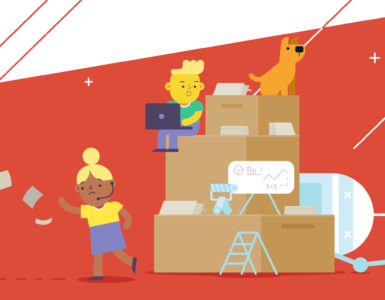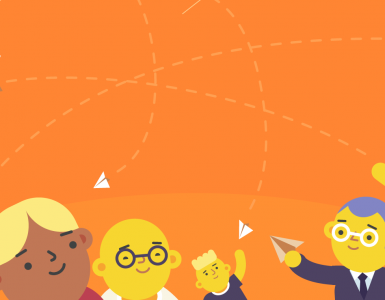Did you know that 71% of employees say they’re more productive when they feel connected to their colleagues through communication? This shows the importance of effective communication in the workplace.
No doubt, the communication techniques used in a work environment affect employee performance and collaboration efforts. Top-down communication is a common form of communication in the workplace and has both positive and negative impacts on collaboration efforts and employee engagement. While top-down communication can provide clarity about organizational goals and expectations, it can also create barriers between management and employees, potentially leading to disengagement.
What does downward communication mean? How does it affect performance and collaboration at work? What can businesses do to generate employee engagement effectively?
In this article, you’ll learn the impact of this form of communication and how businesses can improve employee engagement and collaboration efforts among employees. You’ll discover practical ways to improve communication and teamwork through practical strategies and real-life examples. Ready? Let’s go!
What is downward communication and how it works
Any form of communication from a manager to an employee, whether it comes from their direct manager or someone else in their management chain, is defined as downward communication. Depending on how individuals process information and respond to stressors, this type of communication can positively or negatively affect employee engagement, performance, and morale.
Also known as “top-down communication,” this type of communication involves vertically sending messages to the bottom of an organization’s hierarchy. Downward communication is only deemed successful when the person in the organization’s lowest position receives the message.
In an ideal world, each level within an organization works with those above and below to carry out daily tasks and move projects forward. In practice, many organizations need better communication between departments, perhaps notably within a company’s upper management levels.
One reason is that many managers don’t communicate effectively with their employees. This leads to miscommunication or confusion over who is responsible for what task and why it must be done. Effective downward communication is important because it ensures that employees clearly understand expectations, priorities, and organizational goals, which in turn drives productivity and engagement. To avoid communication issues, managers must learn the best medium of communication for their organization, be it face-to-face interaction, email, or written memos.
Examples of downward communication
Top-down communication is common in organizations, especially when management needs to convey important information, provide direction, or clarify business goals. This form of communication ensures that employees are aligned with the organization’s goals. Here are some key examples of top-down communication in the workplace:
- Project Feedback: Managers provide feedback on project progress, from highlighting successful outcomes to suggesting areas for improvement.
- Annual reports: Summarise the company’s key performance indicators, financial details, and achievements. These reports keep employees informed of the organization’s direction and success.
- Company policy announcements: New policies or changes to existing policies are communicated to ensure all employees are aware of updates or expectations.
- Clarification of corporate goals: Management explains the organization’s vision, strategic goals, and objectives to ensure employees understand their role in achieving them.
- Training and development: Communicating training programs helps employees develop the skills and knowledge required for their roles.
- Performance appraisals: Regular appraisals are communicated to employees, providing feedback on strengths, areas for improvement, and future goals.
- Job instructions: Managers or supervisors issue clear job instructions to ensure employees understand their responsibilities and expectations.
- Notices or updates: Important changes, such as policy updates, schedule changes, or urgent announcements, are communicated to ensure employees are kept informed.
Mediums of top-down communication
Selecting the right medium for downward communication is crucial for ensuring that messages are delivered efficiently and clearly. Various tools and methods can be used, depending on the nature of the message and the need for immediacy. Common mediums of downward communication include:
- Emails: A preferred choice for formal communication, email allows for detailed messages and provides a documented record of the information shared.
- Memos and newsletters: Memos are often used for formal communication, while newsletters keep employees updated on company news, policies, and upcoming initiatives.
- Phone conversations: For more urgent or personal matters, phone calls provide direct, real-time communication, ensuring clarity and immediate feedback.
- Staff meetings (physical discussions): Face-to-face meetings facilitate direct interaction, allowing for in-depth discussions, immediate questions, and immediate clarification. This medium is often used for strategic or complex information.
How to effectively generate employee engagement?
How your employees feel about your organization daily is part of how we measure employee engagement. The second part is the energy they bring to the office. This energy can be contagious, inspiring others to bring the same enthusiasm to their work. However, it can get difficult to maintain your employee engagement, which can impact workflow.
Maintaining employee engagement will increase performance, leaving the team happier and, in the end, increasing productivity. When employees feel more connected to their work, they are more likely to put in the extra effort that ultimately benefits the organization.
Here are the top tips to help your organization boost employee engagement.
Recognize your employees
One way to increase employee engagement and productivity is to recognize their efforts. Everyone likes their efforts to be recognized. When this is achieved, employees feel valued and motivated to do more work. Also, if you’re struggling with employee retention, recognizing your employees helps with that.
Additionally, when an employee is recognized, others are likely to be inspired to be recognized as well. The result? A significant boost in workplace morale.
Come up with different ideas for recognizing your team. For example, you can recognize your employees by sending emails praising them and celebrating their work achievements, anniversaries, and birthdays. When employees feel wanted and appreciated, their morale will improve and they will become more engaged.
Encourage feedback
Like recognition, feedback increases employee engagement. Start by encouraging managers to have frequent review meetings with members of their team. These reviews should focus on both successes and areas for improvement. This will help employees feel supported and guided in their roles. Another way to get feedback from employees is to conduct internal surveys. Surveys help organizations measure employee interests and receive suggestions and opinions. It also gives employees a voice in shaping company policies and practices, making them feel more involved. This encourages collaboration.
Properly onboard and train recruits
An easy way to engage employees with their jobs and make them feel like a part of your organization is to onboard them properly. Proper onboarding forms the foundation of their experience in your company while also setting the tone. A thorough onboarding process not only covers the basics. It also introduces new employees to the company culture and helps them feel welcomed and supported. Also, when an organization takes its time to train employees, it helps them hone their skills, making them feel valued and improving their performance.
Prioritize mental and physical health
Employees will likely engage better with their jobs when their organizations know how to prioritize their mental health. The same principle applies to physical health. Investing in employee well-being demonstrates a commitment to their overall happiness and success. You can organize a wellness initiative for each employee to score high in this category.
For instance, the organization can collaborate with a gym to offer membership discounts. Also, a meditation class can help employees take a break when they are overwhelmed and dealing with burnout. Encouraging regular breaks and providing stress management resources can significantly reduce burnout. This will go a long way to improving employee performance.
Benefits of downward communication
This form of communication in the workplace has both benefits and drawbacks. On the one hand, it creates a sense of unity within the organization as it is a way to maintain an open line of communication between the executive level and the rank-and-file employees. This clear communication structure helps avoid confusion and keeps everyone on the same page, which can be particularly important during times of organizational change.
However, this type of communication is less effective in other ways, such as ensuring all employees are on board with company policy. Some employees may feel less engaged in decision-making, as they are merely recipients of information rather than contributors. Find below some advantages of top-down communication.
It makes responsibility delegation easy
Delegation is essential for productivity in the workplace. When managers don’t delegate, the organization performs poorly. Employees feel left out and irrelevant. However, with a well-established downward flow of communication, managers can easily clarify who is responsible for what, reducing uncertainty and overlap. What this form of communication does is help managers or executives conveniently delegate tasks. When information is passed from the top to the bottom, as in the case of downward communication, the workplace is healthier, and performance increases. By clearly stating expectations, it also ensures that employees understand their role in the broader organizational goals. Top-down communication also simplifies the process of assigning and distributing tasks.
It instills discipline
Typically, this type of communication involves passing information from the highest level of the organization to the lowest. This form of communication results in employees following the instructions given by managers. This compliance can be particularly beneficial in high-stakes environments where adherence to company policies is critical. It also promotes discipline in the work environment, thereby increasing productivity.
It increases efficiency
The future workplace relies on efficiency. When instructions are given from the top down in an organization, it not only instills discipline but also increases efficiency. Clear direction from higher-ups eliminates the need for multiple rounds of clarification, helping employees to work with greater focus. This is because senior managers can coordinate the instructions coming from their positions. Employees can also easily get feedback from their supervisors or managers. This continuous feedback loop ensures that issues are addressed promptly, leading to faster problem resolution and improved overall performance. The result is increased performance and collaboration.
Drawbacks of downward communication
Communicating downward can have negative consequences for those who work hard but need recognition or acknowledgment from upper management. In these cases, top-down communication becomes a form of control used by the managers to keep their reports in check. Here are some drawbacks to this kind of communication.
It breeds misunderstanding
Messages passed from one person to another are likely to be misinterpreted. The reason is that people interpret simple instructions differently. Also, when a message is passed from one person to multiple people, it seldom gets to the last person in one piece.
After painstakingly updating managers about important information, you find out that the message seems to change as it gets to the bottom of the hierarchical ladder. At most, you’ll either have to send a general email created, e.g. using email template creators or hope it doesn’t get distorted before it gets to the last person. This can affect collaboration efforts and employee performance.
Feedback is often slow
Another disadvantage of downward communication is that it doesn’t allow for rapid feedback. The back and forth from higher up, then down the organizational ladder, up again is time-consuming. The inefficiency of communication creates unnecessary delays and can prevent urgent issues from being addressed quickly. This leads to distorted messages, slow feedback, and sometimes problems resulting from delayed feedback and, ultimately, low performance. Employees may be reluctant to raise concerns if they know they will not receive a timely response.
Top-down communication can be demoralizing
This form of communication is directive; hence, it doesn’t allow employees and management to communicate effectively. Employees’ views, opinions, and suggestions can only be discussed with the higher-ups, resulting in a lack of motivation and frustration. Over time, this lack of engagement can reduce employees’ sense of ownership in their work, leaving them feeling undervalued and disconnected from the organization. This can have a negative impact on collaboration and performance. To combat this, organizations need to consider more inclusive communication practices to keep employees motivated and involved.
The key to employee collaboration and performance is employee engagement
Despite the hype and hoopla, too many businesses still need help to improve employee engagement to boost performance and collaboration efforts. This is partly due to organizations still relying too much on traditional management and leadership practices. These outdated methods often fail to recognize the dynamic needs of today’s workforce, leading to missed opportunities for growth and innovation.
Rather than engaging employees directly with clear objectives, guidance, and feedback, managers often rely strictly on downward communication strategies. This approach limits the two-way communication that is essential to fostering a sense of involvement and ownership among employees. Unfortunately for performance and collaboration, this type of communication is not very effective. Without meaningful dialogue, employees can feel disconnected and less motivated to contribute to the team’s success. I would be interested to hear how this type of communication has impacted employee performance and collaboration in your organization.









Add comment